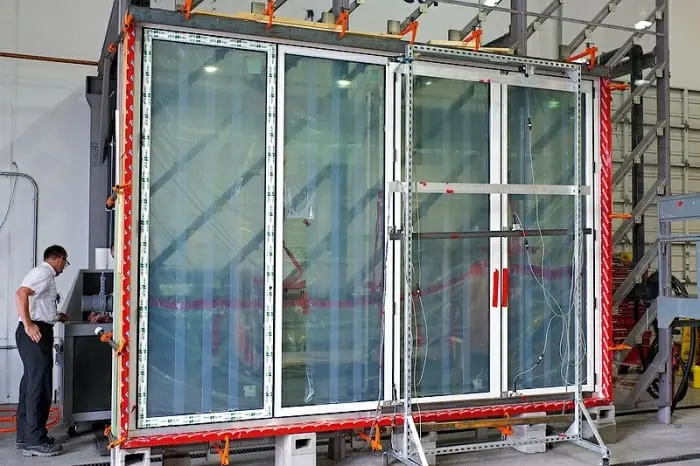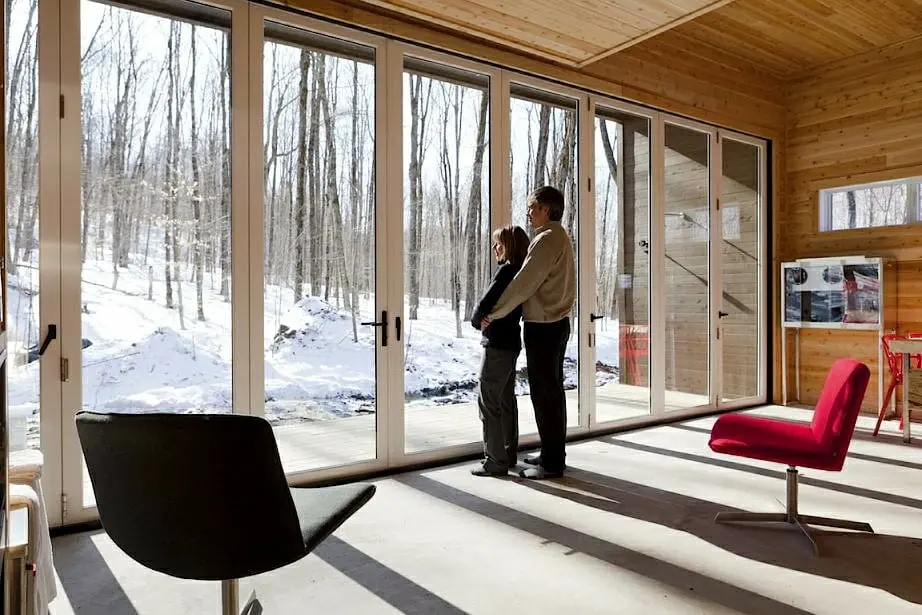In this article, the terms NAFS and NAFS-08 refer to AAMA/WDMA/CSA 101/I.S.2/ A440-08, NAFS—North American Fenestration Standard/Specification for windows, doors and skylights.
[This article was updated on April 20, 2017, to address testing of folding door systems under NAFS-11.]
What are Folding Doors?
Folding doors are multi-panel side hinged exterior doors that can fold, slide and stack to one or both sides to provide the largest possible clear openings. They are known by several additional and related names, such as bifolding doors, folding sliding doors, and accordion or “concertina” doors.

What makes these doors unique is that all sliding panels are hinged to one another, and every pair of panels has guide rollers at top and bottom that travel within tracks at the head and sill.
Folding door frames can be made from materials such as aluminum, wood, aluminum-wood hybrids, fiberglass, and steel reinforced vinyl. Some systems have limited ability to resist air and water leakage, and must be protected from driving rain by deep overhangs. Other systems can resist full exposure to the weather, and have tested NAFS Performance Grade ratings for air, water and structural performance.
Folding Doors and the Code
One question I hear frequently is “Do folding doors have to be NAFS tested to comply with the Building Code?” This question does not have a simple answer, at least not in British Columbia, where every municipal building department can independently interpret and apply the Code. I recall a senior code administrator telling me that BC building officials “have the authority, but not the responsibility, to enforce the Code”.
The 2010 National Building Code of Canada and provincial codes such as the 2012 BC Building Code and the 2014 Ontario Building Code generally require “manufactured fenestration products” to be tested to the NAFS-08 standard and to be labeled with Performance Grades appropriate for the building’s geographic location and climate.
Because they are exterior doors, the building code expects them to have the same resistance as other side hinged doors to forced entry resistance, air infiltration and the structural pressure of wind storms. When folding doors do not have significant overhang protection, they need to provide the same resistance to water penetration as windows and sliding glass doors.

Some manufacturers claim that folding doors do not need to be tested for air-tightness, wind load resistance, or water penetration because they are not named as a product type in the NAFS-08 standard. Other manufacturers assert that their folding doors are “site built”, and are therefore not subject to NAFS compliance under the Code.
There are jurisdictions that accept these positions. But others will not allow folding door products to be installed without evidence of lab testing to NAFS. They recognize that while Canadian building codes do exempt site-built products from compliance with all the provisions of the NAFS standard, these codes still require site-built products to meet the same functional performance expectations as other windows, doors and skylights: to resist rain penetration and wind loads, control air leakage, and provide forced entry resistance. If some manufacturers of folding doors can do so, why not expect the same of all?
There are, of course, situations where lab testing is simply not possible, or is impractical. There is a well respected view that the site-built exemption in Part 9 of the building code is intended to address products that are one-off, custom-made for a specific building, and significantly different from a standard product so as to make testing impractical. An example of this would be a product of unusual size or geometric shape that cannot be factory built. Information Bulletin B13-06 from the BC Building Safety and Standards Branch articulates such an understanding of site-built products.

Can You Test Folding Doors Under NAFS-08?
As folding doors are not a named product type in the 2008 edition of the standard, there are no minimum test sizes or defined Performance Class requirements for them. However, that doesn’t mean they cannot be tested to achieve a Performance Grade as well as water penetration resistance and Canadian air infiltration/exfiltration ratings.
The NAFS standard actually has a Specialty Product (SP) product type for testing and rating the performance of products not specifically defined in the standard.
Specialty products can be tested for air-water-structural ratings, and any additional applicable tests in the NAFS standard that the manufacturer wishes to perform, such as tests for forced entry resistance. The ratings apply to sizes up to the size tested, just like any other product tested under NAFS.
Specialty products can also be enrolled in third party certification programs to provide purchasers with additional assurance that the manufacturer’s labeled product ratings are valid and based on laboratory testing of the products.

Can You Test Folding Doors Under NAFS-11? (Update)
Careful readers of NAFS-11 will notice that in Clause 1, the list of products “not intended to be tested to this standard” includes “folding door systems”. This statement caused significant concern to manufacturers that had been testing folding doors as Specialty Products under NAFS-08. These manufacturers brought their concerns to the Joint Document Management Group (JDMG) comprised of members from each of the three associations responsible for the creation of NAFS: the American Architectural Manufacturers Association (AAMA), the US-based Window and Door Manufacturers Association (WDMA), and the Canadian Standards Association (CSA).
Fortunately for those manufacturers, the JDMG technical interpretation TI 15-03 allows folding doors to continue to be tested as Specialty Products under NAFS-11, as discussed in this previous blog post. Download JDMG 15-03 to read the bulletin in its entirety.
How Should the “Size Tested” Parameter Apply to Folding Doors?
Folding doors are a modular product in which you can keep adding panels more or less without limit. It is generally accepted that a 1L-3R product configuration has all the interfaces, operating modes and hardware items that one would have in a folding door system, and that the NAFS test of a such a door should qualify a folding door of any configuration, and any number of panels, as long as the panel size of the tested door is not exceeded.
This is both a logical application, and a practical one, as it is physically impractical to test a door with more panels: most test labs cannot handle specimens of greater width, and adding more panels of the same type to the test does not add any more information to the test report.
Folding doors in NAFS-17?
Given the increasing popularity of folding doors, and a growing number of manufacturers willing to voluntarily test doors to NAFS-08, there could well be a Folding Door product type in the next edition of the NAFS standard, scheduled for 2017.



